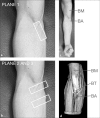Ultrasound visualization of an underestimated structure: the bicipital aponeurosis
- PMID: 28597034
- PMCID: PMC5681602
- DOI: 10.1007/s00276-017-1885-0
Ultrasound visualization of an underestimated structure: the bicipital aponeurosis
Abstract
Purpose: We established a detailed sonographic approach to the bicipital aponeurosis (BA), because different pathologies of this, sometimes underestimated, structure are associated with vascular, neural and muscular lesions; emphasizing its further implementation in routine clinical examinations.
Methods: The BA of 100 volunteers, in sitting position with the elbow lying on a suitable table, was investigated. Patients were aged between 18 and 28 with no history of distal biceps injury. Examination was performed using an 18-6 MHz linear transducer (LA435; system MyLab25 by Esaote, Genoa, Italy) utilizing the highest frequency, scanned in two planes (longitudinal and transverse view). In each proband, scanning was done with and without isometric contraction of the biceps brachii muscle.
Results: The BA was characterized by two clearly distinguishable white lines enveloping a hypoechoic band. In all longitudinal images (plane 1), the lacertus fibrosus was clearly seen arising from the biceps muscle belly, the biceps tendon or the myotendinous junction, respectively. In transverse images (plane 2) the BA spanned the brachial artery and the median nerve in all subjects. In almost all probands (97/100), the BA was best distinguishable during isometric contraction of the biceps muscle.
Conclusion: With the described sonographic approach, it should be feasible to detect alterations and unusual ruptures of the BA. Therefore, we suggest additional BA scanning during clinical examinations of several pathologies, not only for BA augmentation procedures in distal biceps tendon tears.
Keywords: Biceps brachii muscle; Bicipital aponeurosis; Lacertus fibrosus; Ultrasonography.
Conflict of interest statement
The authors declare that they have no conflict of interest.
Figures




References
-
- Bassett FH, 3rd, Spinner RJ, Schroeter TA. Brachial artery compression by the lacertus fibrosus. Clin Orthop Relat Res. 1994;307:110–116. - PubMed
-
- Biemans RG. Brachial artery entrapment syndrome. Intermittent arterial compression as a result of muscular hypertrophy. J Cardiovasc Surg (Torino) 1977;18:367–371. - PubMed
MeSH terms
LinkOut - more resources
Full Text Sources
Other Literature Sources

